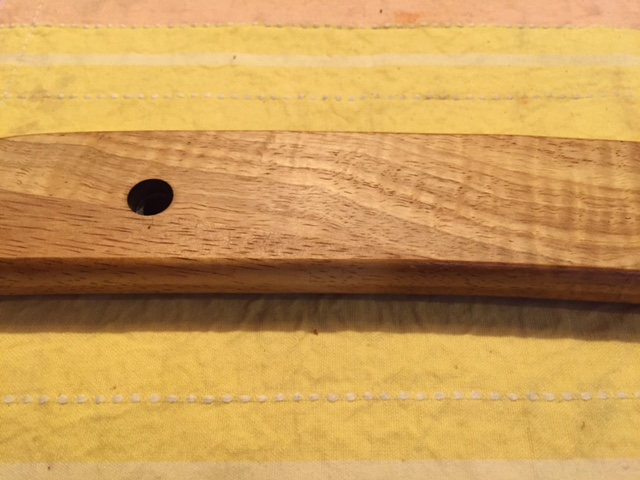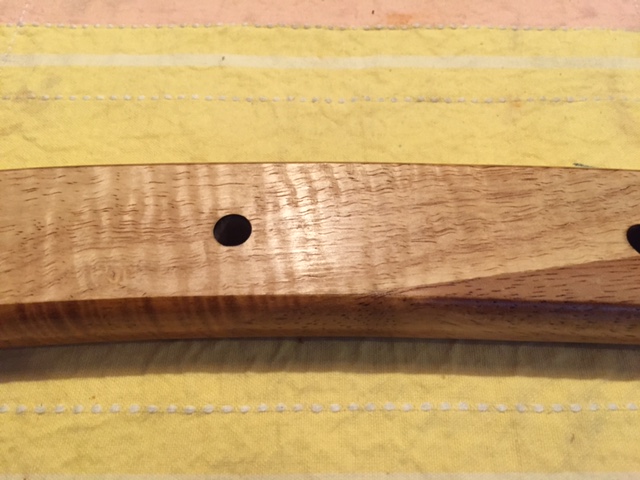Posts: 844
Threads: 0
Joined: Aug 2014
I have been on a recent reading binge on what little I've found about wood burnishing. This includes the "polissoir" topic of late, as well as other topics such as "boning" a wood surface. I don't yet have a polissoir or any special burnishing tools.
Along with the reading, I was resawing some wood and I noticed a special 'glisten' after smoothing it with one of my wood-body planes.
So, here is experiment #1 for me. A piece of 'mystery wood' that I salvaged from one of my wife's department-store chairs that she had in her single days way back. Out of the whole table-chairs set, one leg was made of "fiddled grain".
I planed both sides of this blank. As it turns out, even a 55-degree HNT Gordon was getting a bit of tearout, but my Sargent 407 mini-plane with chipbreaker did a decent job.
Side 1 is just planed and waxed:
Side 2 is planed the same way, but burnished with a hard piece of Desert Ironwood, then waxed:
The burnished side is noticeably brighter and feels much smoother to the touch.
I'm excited!
Chris
Chris
Posts: 116,077
Threads: 0
Joined: Jun 2002
Location: Sparkling Clearwater, Fl. Tampa Bay Area
(08-15-2017, 08:04 PM)C. in Indy Wrote: I have been on a recent reading binge on what little I've found about wood burnishing. This includes the "polissoir" topic of late, as well as other topics such as "boning" a wood surface. I don't yet have a polissoir or any special burnishing tools.
Along with the reading, I was resawing some wood and I noticed a special 'glisten' after smoothing it with one of my wood-body planes.
So, here is experiment #1 for me. A piece of 'mystery wood' that I salvaged from one of my wife's department-store chairs that she had in her single days way back. Out of the whole table-chairs set, one leg was made of "fiddled grain".
I planed both sides of this blank. As it turns out, even a 55-degree HNT Gordon was getting a bit of tearout, but my Sargent 407 mini-plane with chipbreaker did a decent job.
Side 1 is just planed and waxed:
Side 2 is planed the same way, but burnished with a hard piece of Desert Ironwood, then waxed:
The burnished side is noticeably brighter and feels much smoother to the touch.
I'm excited!
Chris ,,,,,,,,,,,,,,,,,,,,,,
I suspect it's because the "unburnished" surface has microscopic fibers sticking out from the surface, while the burnisher has flattened or compressed those fibers, but I could be wrong.
Often Tested. Always Faithful. Brothers Forever
Jack Edgar, Sgt. U.S. Marines, Korea, America's Forgotten War
Get off my lawn !

Posts: 20,950
Threads: 0
Joined: May 2005
08-16-2017, 08:25 AM
(This post was last modified: 08-16-2017, 08:27 AM by MichaelMouse.)
Lots of turners burnish, some even intentionally, while others simply heat and harden the surface with worn-out sandpaper. Does pose a problem with some finishes, however. Sometimes cohesion overcomes adhesion, just as it does with multiple coats of finish, and no "toothing" in between. Not a problem with something fairly open-grained like your mystery tropical wood, but a well-burnished piece of maple needs some serious thinning for the first coat to get it to lay flat.
Sharp irons and feather-thin shavings make all planes equal as their heel burnishes the surface. Even iron planes. I have found bevel-up low angle to work best on the domestic hardwoods I use. Silly as it seems. I do have a York pitch to smooth squirrely grain, but the slick seems favored by the low angle. Couple of experiments for you to try are wood shavings, as many turners use, because they conform to non-planar surfaces, and the lathe moves the wood. Use the shavings produced by the wood in use or something a bit softer, or you might scratch. Press and sweat. Second experiment is to put a couple thicknesses of kraft paper instead of sandpaper in your speed bloc or similar vibrator sander and apply a bit of pressure as you "sand" your surface.
Better to follow the leader than the pack. Less to step in.
Posts: 10,717
Threads: 1
Joined: Jan 2006
Location: Orlando, Florida
Abrasion smooths things out, that's for sure. I suspect that part of the reason a polissoir works is the abrasion / polishing that happens when the polissoir is pressed hard against the surface to be waxed. Before I opened up this thread, that's what I thought you were experimenting with.
Still Learning,
Allan Hill
Posts: 12,299
Threads: 0
Joined: Mar 2006
So, envision a woody, with instead of a blade, having a piece of highly polished carbide, with the wood bearing surface being a few thoudsandths above the surface of the plane sole. Worth experimenting with?
Posts: 844
Threads: 0
Joined: Aug 2014
I have been thinking a lot!
Really when one talks about planes, scrapers, or even sandpaper, these are in the "Edge" category of "woodworking with wedge and edge". Even in the world of Kanna planes, the intention with the perfect smoother is for an edge followed by no burnishing, which is great for a certain number of scenarios. But, when you burnish an edge or burnish a workpiece, you are after a "rolling and compressing" action, with no edge.
This article on using a Bone burnisher is what strongly piqued my interest lately. It's a good one! The burnisher is most definitely harder than the workpiece:
https://eccentrictoolworks.com/2010/05/
I must emphasize that my pictures above really showed something different than what I've ever got from any cutting tool, no matter how finely tuned. Stuff is 'rolled' and it feels vastly more interesting. Since I've been wanting to use fewer and thinner film finishes, this is exciting to me.
Chris
Chris
Posts: 12,299
Threads: 0
Joined: Mar 2006
Interesting article! After my earlier post this morning, I went into the shop for a few moments, put a piece of curly maple in my vise and grabbed a piece of very highly polished carbide (from my plant and far smoother than any burnisher sold commercially). I used the carbide on the maple's 3/4" wide edge (already planed) and took it a few more degrees further towards a buttery feeling. I then tilted the burnish on the edge, and made a perfect "eased" edge-not a chamfer or radius, but just burnished the sharpness away with a couple of strokes.
Posts: 116,077
Threads: 0
Joined: Jun 2002
Location: Sparkling Clearwater, Fl. Tampa Bay Area
(08-17-2017, 10:26 AM)Tony Z Wrote: Interesting article! After my earlier post this morning, I went into the shop for a few moments, put a piece of curly maple in my vise and grabbed a piece of very highly polished carbide (from my plant and far smoother than any burnisher sold commercially). I used the carbide on the maple's 3/4" wide edge (already planed) and took it a few more degrees further towards a buttery feeling. I then tilted the burnish on the edge, and made a perfect "eased" edge-not a chamfer or radius, but just burnished the sharpness away with a couple of strokes.
...............
One question Tony...what do you use in your plant to polish carbide, assuming carbide cannot be "burnished" by compressing..I'm thinking it is diamond.
My assumption posted earlier is that wood fibers that are cut, still leave a microscopically "fuzzy" surface, and burnishing it compacts and compresses the fibers protruding from surface to produce a polish.
Often Tested. Always Faithful. Brothers Forever
Jack Edgar, Sgt. U.S. Marines, Korea, America's Forgotten War
Get off my lawn !

Posts: 12,299
Threads: 0
Joined: Mar 2006
Jack,
Tooling we use, that requires close tolerance through holes, generally has the core pins made of carbide, if the quantity is high. We typically discard core pins after "X" pieces, depending upon size, and when core pin size is greater than, say, .500", we generally go to other materials.
My carbide is supplied by an outside tooling source and is very highly polished, far more than any commercial burnisher sold, such as the ones from LN, LV or whoever.
T.Z.
Posts: 116,077
Threads: 0
Joined: Jun 2002
Location: Sparkling Clearwater, Fl. Tampa Bay Area
Thanks Tony..
Often Tested. Always Faithful. Brothers Forever
Jack Edgar, Sgt. U.S. Marines, Korea, America's Forgotten War
Get off my lawn !

|










